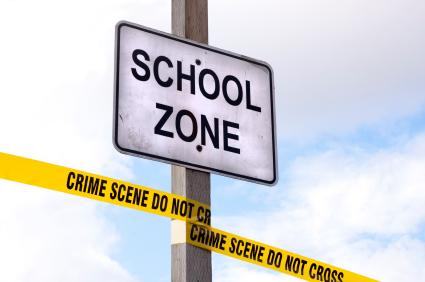PROVIDENCE, R.I. [Brown University] — It’s hard to go a day without seeing news of violence in some form occurring in schools around the country, and Chicago is often cited as a city where crime rates in schools are particularly high. In a new study in the current issue of Sociology of Education, Brown University sociologist Julia Burdick-Will looked at the effect such violence has on school achievement among Chicago high school students. She found that while violent crime has a negative impact on standardized test scores, it doesn’t have the same effect on grades.
“It seems obvious that having fights in schools is not a good thing for achievement, but it’s a really difficult thing to show,” said Burdick-Will, a post-doctoral research associate in the Population Studies and Training Center at Brown University, whose study is titled “School Violent Crime and Academic Achievement in Chicago.”
Employing detailed crime data from the Chicago Police Department, administrative records from Chicago Public Schools, and school climate surveys conducted by the Consortium on Chicago School Research from 2002 to 2010, Burdick-Will compared fluctuations in year-to-year violent crime rates with changes in both student standardized test scores and annual grade point averages.
She found that violent crime in schools adversely affects reading and math scores on standardized tests, but has no influence on GPAs.
Burdick-Will said the results suggest that violent crime rates affect the amount of material learned by the entire student body, but not the study skills or effort of individual students. GPAs, she points out, not only reflect learning, but also student behavior and standing within the classroom. Test scores are a more objective measure of content knowledge and performance on a given day.
“So you would expect that if what’s really going on is students are distracted and not learning as much and also not able to perform as well on the day of the test that it would affect their test scores,” Burdick-Will said. “But it wouldn’t necessarily affect how much homework they’ve turned in over the course of the year. You’re still going to have that kid who is really eager; he or she is just not going to know as much.”
The study also reveals that students’ perceptions of safety go relatively unchanged, even in years when violent crime rates are low. One explanation may be that the research only looks at reported crimes that involved police intervention. There could be many more incidents, such as shoving in the hallway and verbal altercations, that go unreported but still have an effect on students’ sense of well-being.
While annual violent crime rates generally fluctuated significantly at individual schools during the eight-year study period, Burdick-Will found that the average violent crime rate for all high schools in the district combined changed very little over the study period. The paper also notes that a few high schools each year accounted for the large majority of violent crimes in the whole district.
Burdick-Will thinks her research demonstrates the need for policy changes that consider education and crime rates together and take into account the “collateral damage” that crime and violence have on multiple sectors of society.
“In an age of increasing school accountability and shrinking public budgets, it is important to understand how policies that on the surface only affect one social sphere, such as policing strategies, have larger consequences for other social institutions, including schools, in ways that have lasting impacts on individual life chances and national levels of inequality,” Burdick-Will said.

